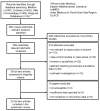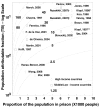Tuberculosis incidence in prisons: a systematic review
- PMID: 21203587
- PMCID: PMC3006353
- DOI: 10.1371/journal.pmed.1000381
Tuberculosis incidence in prisons: a systematic review
Abstract
Background: Transmission of tuberculosis (TB) in prisons has been reported worldwide to be much higher than that reported for the corresponding general population.
Methods and findings: A systematic review has been performed to assess the risk of incident latent tuberculosis infection (LTBI) and TB disease in prisons, as compared to the incidence in the corresponding local general population, and to estimate the fraction of TB in the general population attributable (PAF%) to transmission within prisons. Primary peer-reviewed studies have been searched to assess the incidence of LTBI and/or TB within prisons published until June 2010; both inmates and prison staff were considered. Studies, which were independently screened by two reviewers, were eligible for inclusion if they reported the incidence of LTBI and TB disease in prisons. Available data were collected from 23 studies out of 582 potentially relevant unique citations. Five studies from the US and one from Brazil were available to assess the incidence of LTBI in prisons, while 19 studies were available to assess the incidence of TB. The median estimated annual incidence rate ratio (IRR) for LTBI and TB were 26.4 (interquartile range [IQR]: 13.0-61.8) and 23.0 (IQR: 11.7-36.1), respectively. The median estimated fraction (PAF%) of tuberculosis in the general population attributable to the exposure in prisons for TB was 8.5% (IQR: 1.9%-17.9%) and 6.3% (IQR: 2.7%-17.2%) in high- and middle/low-income countries, respectively.
Conclusions: The very high IRR and the substantial population attributable fraction show that much better TB control in prisons could potentially protect prisoners and staff from within-prison spread of TB and would significantly reduce the national burden of TB. Future studies should measure the impact of the conditions in prisons on TB transmission and assess the population attributable risk of prison-to-community spread. Please see later in the article for the Editors' Summary.
Conflict of interest statement
The authors have declared that no competing interests exist.
Figures




References
-
- Angie B, Ann A, Malgosia G, Michael K, Hans K, et al. Geneva: World Health Organization; 2000. Tuberculosis control in prisons: A Manual for Programme Managers.
-
- Dara M, Grzemska M, Kimerling ME, Reyes H, Zagorskiy A. The Global Health Bureau, Office of Health, Infectious Disease and Nutrition (HIDN), US Agency for International Development; 2009. Guidelines for control of tuberculosis in prisons.
-
- Niveau G. Prevention of infectious disease transmission in correctional settings: a review. Public Health. 2006;120:33–41. - PubMed
Publication types
MeSH terms
LinkOut - more resources
Full Text Sources
Medical

